Data Governance Policy: Examples, Templates & How to Write One

Share this article
A data governance policy is a documented set of guidelines that ensure an organization’s information assets are managed consistently.
In this article, we’ll explore the concept of data governance policy and its types, check out some examples of good data governance policies, and provide a draft template to get started on yours.
Table of contents #
- What is a data governance policy?
- Data governance policy types: An overview
- Data governance policy: What does it involve?
- Setting effective data governance policies: Getting started
- Data governance policy examples and templates
- Data governance policy: Related reads
What is a data governance policy? #
Data governance policy outlines the rules of engagement with data, overseeing how you access data assets and what operations you carry out on those assets. It ensures compliance with internal rules and applicable legislation and standards.
Effective data governance policies help establish a framework for managing data assets consistently while supporting strategic business objectives.
Additionally, they help you understand what data governance procedures are in place (and why), who is responsible for them, and how they should be managed.
Data governance policy types: An overview #
Since data governance as a principle includes directives across people, processes, and technologies, data governance policies should be equally comprehensive.
Gartner identifies six data governance policy types — data quality, privacy, security, lifecycle, ethics, and definitions and models.
Let’s explore the specifics of each policy to flesh out the role they play in data governance:
- Data quality policy: Ensures that your data is fit for purpose by tracking quality metrics, such as validity, completeness, timeliness, accuracy, and integrity
- Data privacy policy: Establishes accountability and transparent data management to minimize privacy risks and comply with regulations like GDPR and HIPAA
- Data security policy: Regulates access to valuable information to reduce the risk of security breaches
- Data lifecycle policy: Sets up guidelines outlining data retention, archival, and deletion
- Data ethics policy: Ensures that your data management, use, and collaboration practices align with your organization’s values and morals
- Data definitions and models: Standardizes key concepts, terms, master data domains and critical business KPIs for your organization so that everyone speaks the same language
Data governance policy: What does it involve? #
Establishing and implementing data governance policies includes two stages:
- Setting policies that connect to strategic business outcomes
- Enforcing and executing policies with the help of data stewards (business experts within their respective domains)
In this article, we’ll look into the data governance policy-setting process. We’ll discuss data governance policy enforcement in subsequent articles.
Setting effective data governance policies: Getting started #
Data governance policy setting is the responsibility of business leaders who are part of one or more governance boards or teams. So, building a cross-functional team involving the right people is an excellent way to start.
You should identify key stakeholders for each data governance policy type, such as:
- Members of the risk and compliance team for data privacy policy
- IT stakeholders for data security policy
- Data producers for access, quality, and usage policies
- Data stewards as consultants/advisors because of their extensive business knowledge.
This is also the stage to establish accountability — map roles and responsibilities for the various data governance functions.
The goal of data governance policy setting is to establish data governance policies as well as KPIs to monitor their adoption and enforcement in a collaborative, data-driven manner.
Setting data governance policies involves the following steps:
- Assessing existing policies and exploring how changing them would affect business outcomes of your data and analytics workflows
- Ensuring that the data governance policies (existing as well as new) connect to business outcomes
- Drafting a collaborative data governance policy document
- Adopting an active data governance platform to establish and enforce data governance policies
Let’s explore the specifics.
1. Assessing existing data governance policies: What questions should you ask before changing them? #
Asking these questions can help you set effective policies:
- What do you hope to accomplish with your policy?
- How does it benefit both the individual and the organization as a whole?
- How does it affect productivity (regarding data search and discovery, access, or sharing)?
- How does it impact existing business processes?
- Is there a legal provision or standard certification requirement that you must comply with?
- How easy (or hard) will it be for your teams to adopt and follow these data governance policies?
- How often do you want to review the policy?
The next step is to draft a policy document.
2. Ensuring that the data governance policies connect to business outcomes #
Data governance policies must translate into tangible benefits for your business. Without a clear connection to business outcomes, data governance would be an administrative burden with no real payoff.
For example, your policy on data quality should be tied to business outcomes such as reduced costs or improved efficiency (faster product development cycle, for instance). Data privacy policy could translate to customer trust, brand loyalty, and no hefty GDPR fines.
Meanwhile, clear guidelines on data retention, archival, and deletion (i.e., data lifecycle policy) can translate to lower storage costs and improved compliance.
Next, let’s look at drafting a data governance policy document.
3. Drafting new data governance policies: How do you write a data governance policy document? #
Eugenia Moore, Manager of Data Governance and Quality at Peapod Digital Labs, recommends drafting a short, precise data governance policy document with the following sections:
- Purpose/scope: Why does the policy exist, and how does it support business objectives? It’s important to note that the purpose/scope can change as your business evolves.
- Applicability: Who does the policy affect?
- Definition and acronyms: What phrases and acronyms are essential to define the document? These will set the standards for your organization’s business glossary.
- Responsible stakeholders: What roles have you defined, who will take them, and what will their responsibilities be?
- Exceptions: Who (and also, what) will be exempted from the policy? Why?
- Related policies and references: What other documentation is relevant to the policy? How can you connect the dots for your teams?
Once you’ve drafted the document, the next step is to set things in motion. That’s where an active data governance tool can help.
4. Establishing and enforcing data governance policies: How can a data governance platform help? #
Since setting and enforcing data governance policies is a collaborative process with numerous stakeholders across teams, using an active data governance platform makes it seamless and efficient.
For instance, a platform like Atlan offers a bird’s-eye view of all the data governance policy workflows, metrics, and dashboards at a glance under Policy Center.
More importantly, data governance policy setting is incomplete without connecting to the right business outcomes. That’s where Atlan stands out — we connect policies to data.
You can connect new policies to pre-defined policy types (quality, privacy, security, etc.) and identify the data domains, user roles, or groups that will adhere to them.
You can also use Atlan to draft policy documents, set up approval workflows, monitor policy adoption and enforcement metrics, and more.
Let’s walk through a basic policy-setting workflow to understand how Atlan helps set and enforce data governance policies.
Note: When setting a new policy, you must draft the policy and then an approval workflow before enforcing it.
Drafting a data governance policy in Atlan #
You can draft the policy purpose or scope quickly using Atlan AI — an AI copilot to assist you with documentation, data classification, policy propagation, and more.
After drafting the policy purpose, you can choose the data assets that the policy should govern. Once more, you can use Atlan AI to help speed up this task by auto-suggesting relevant assets.
Atlan also lets you add the technical scope, which goes beyond policy definition and includes details such as the data source, format, tags, and certification status.
This brings policy definition and technical scope under the same umbrella — connecting your data governance policies and establishing a link between the policy’s rules and the specific data sources it governs.
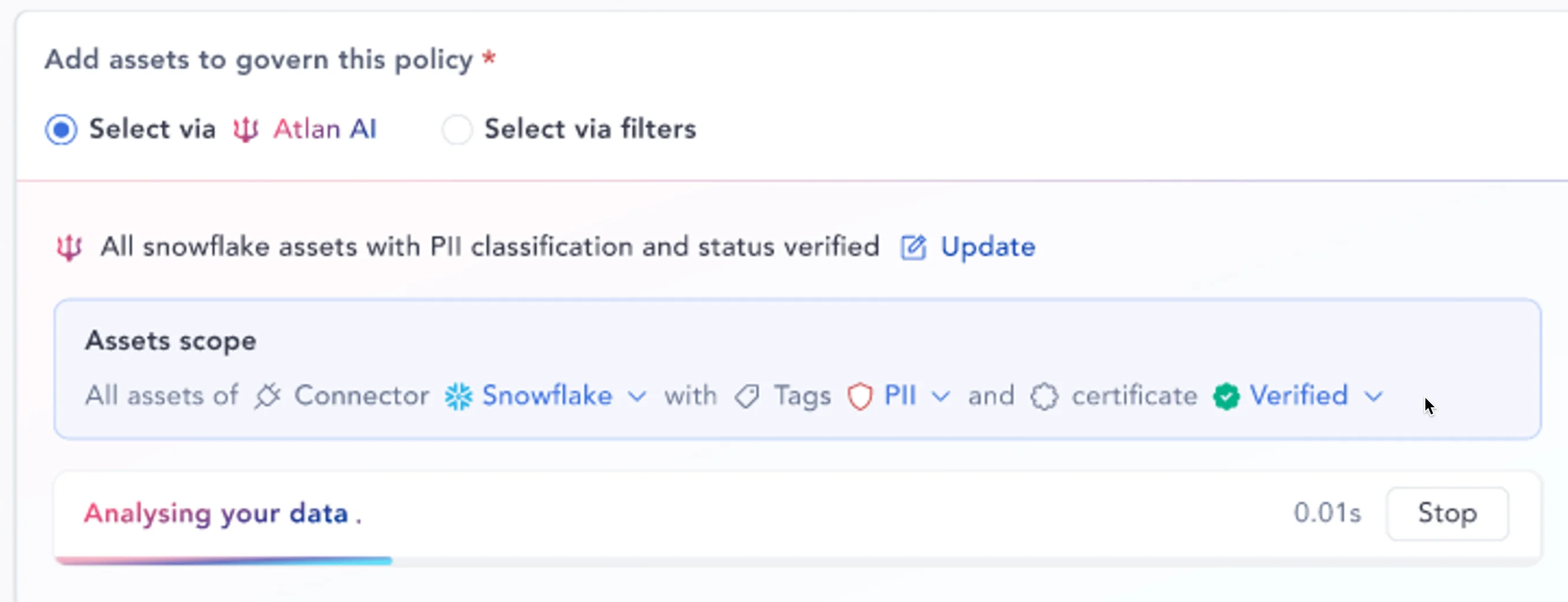
Auto-assigning data assets to relevant data governance policies using Atlan AI - Image by Atlan.
You can attach some business glossary terms to your data governance policy and review them before submitting the policy for approval.
Here’s an example from Atlan: Notice that the policy has a detailed overview, associated business glossary terms, business metrics, etc.
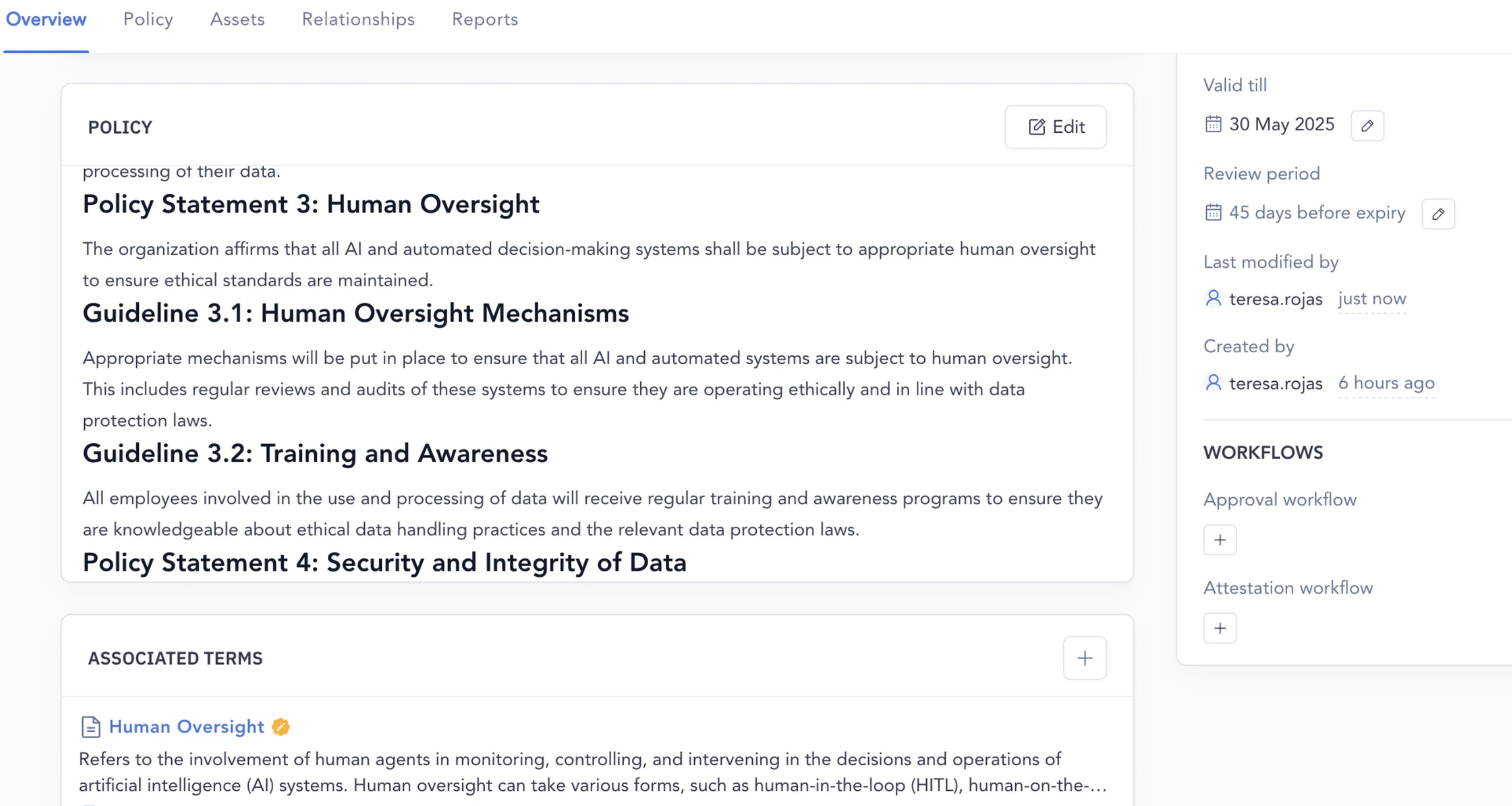
A well-documented data governance policy in Atlan - Image by Atlan.
After submitting your policy, you can track its approval process from the Policy Center homepage.
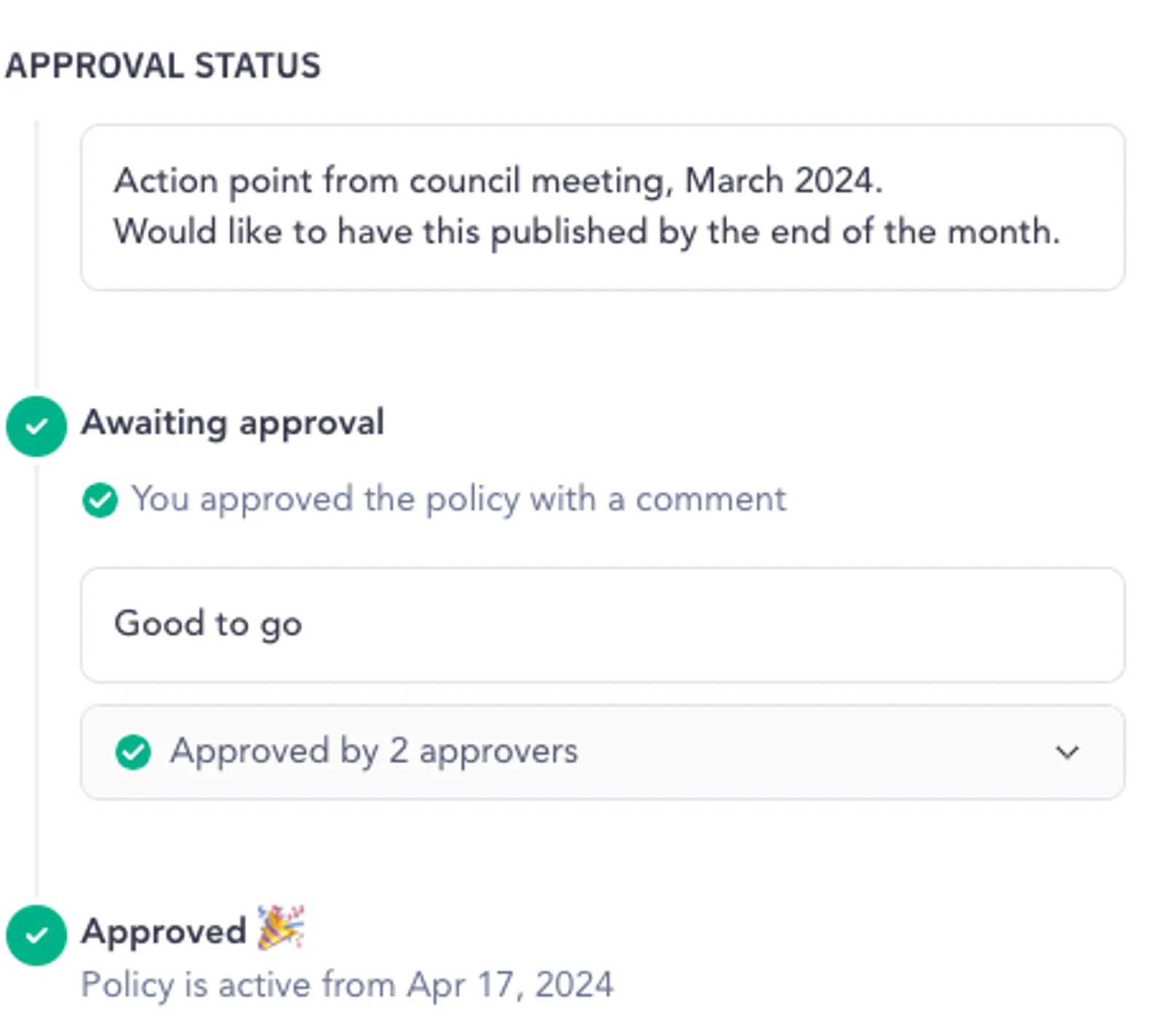
Policy approval status in Atlan - Image by Atlan.
Creating a data governance policy approval workflow in Atlan #
After drafting your policy, you must submit it for approval. This ensures that all the relevant stakeholders have understood, evaluated, and signed off on your data governance policy.
Here’s what a data governance policy approval workflow template looks like in Atlan. The template has automation for policy approval, processes, updates/revisions, and real-time notifications (to be sent to relevant stakeholders).
The templates are predefined and can be configured with drag-and-drop features.
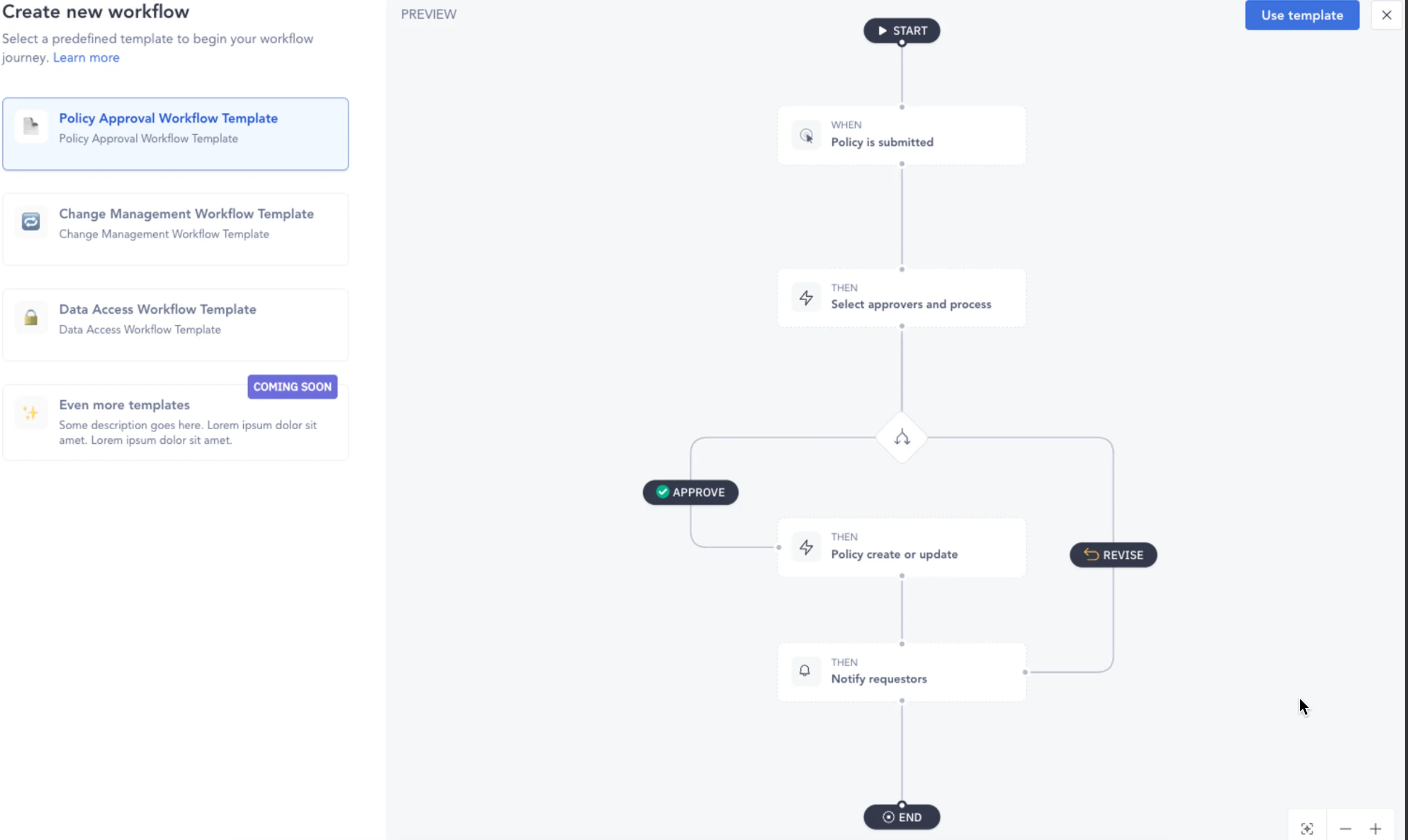
A data governance policy workflow template in Atlan - Image by Atlan.
The approvers, usually business leadership or the data governance committee members, receive all submitted policies in their Atlan Inbox and can review and approve/deny requests from a single location.
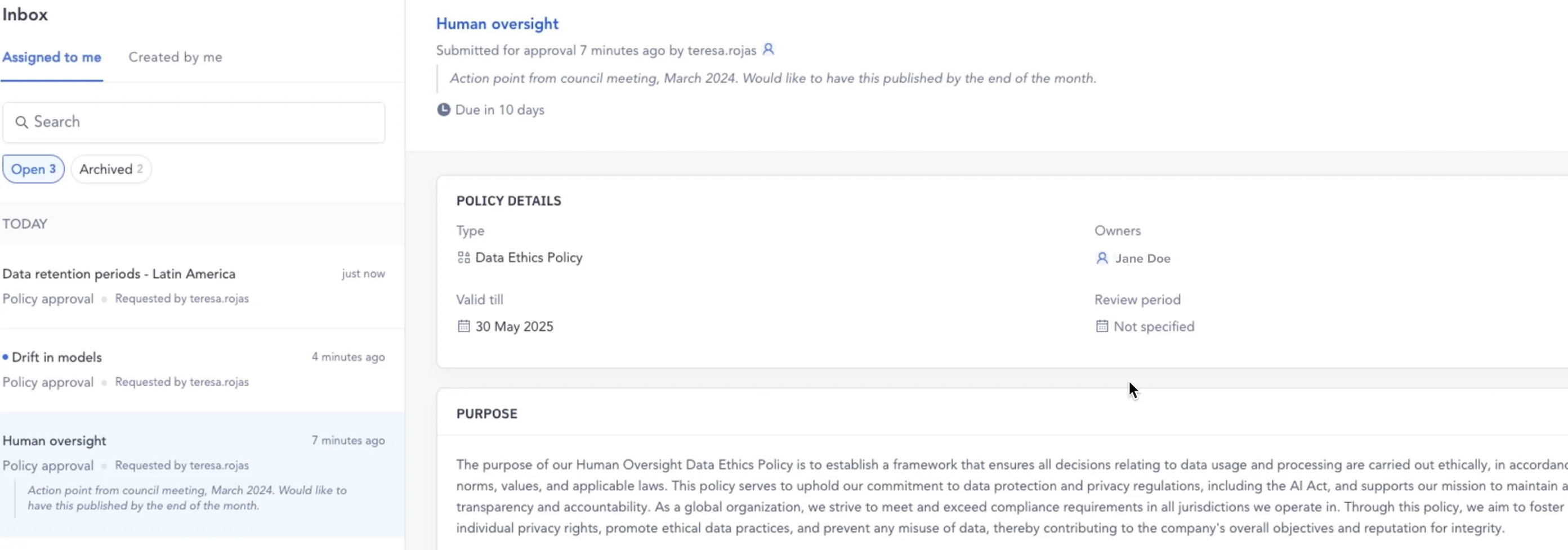
Policy approval messages in Atlan - Image by Atlan.
Once the policy is approved and active, it immediately starts monitoring all the assets it covers. If any assets become non-compliant, an incident will be raised automatically.
So, everything from creating policies to approving and updating them for all data sources can be handled from a single location.
That’s why using an active data governance platform like Atlan is crucial for setting, enforcing, and executing data governance policies at scale, especially for large enterprises with multiple domains and teams spread across regions.
Data governance policy examples and templates #
If your organization is in the early stages of establishing best practices and standards around data, knowing where to start with your data governance policy can be challenging. Here are some publicly-available data governance policies you can use as models for your own:
- Oklahoma Office of Management & Enterprise Services: This data governance document template offers high-level policy and procedure coverage. However, it gets down to the specifics when discussing the groups involved in data governance and their roles and responsibilities.
- New Hampshire Department of Education: This data governance policy example also addresses roles and responsibilities, but dives deeper into the specific job duties of key individuals. Moreover, it outlines the policy’s intended outcomes, which is vital for determining the success of data governance.
- University of New South Wales (UNSW) Sydney: This university separated its data governance into two policies. They have a standard data governance policy and a research data governance & materials handling policy. Creating multiple policies is a practical approach if your organization manages large quantities of data in more than one category that has distinct roles and procedures attached to them.
- East Carolina University: This data governance policy document is short yet precise. It outlines the policy’s scope, maps roles and responsibilities, and establishes accountability.
- Brandeis University: The university created this data governance policy by identifying all the data sources in the organization as a critical first step. Then, they tied each data source to a “data trustee.” This ensures ownership of every single data source across their data estate while also reducing the risk of shadow IT.
- University of Nevada Las Vegas (UNLV): The UNLV data governance policy includes sections on data access, usage, and integrity. Incorporating similar language into your policy will establish standards and expectations that reduce data misuse and build data trust across your organization.
These are just a few examples of what a data governance policy can look like. Pick one that represents your goals and organization communication style most comprehensively, or piece together the strengths of several to serve as your guide to draft your own policy.
Conclusion #
You now have a good understanding of a data governance policy, its importance, and the structure and sections it should include. It’s time to start working on your policy.
To help you get started, review this video from the 2022 Data Governance & Information Quality conference for additional insight into the fundamentals of a governance policy.
If you still feel stuck, consider going back to the basics. Check out this overview of data governance and its purpose, benefits, and best practices.
Data governance policy: Related reads #
- What is Data Governance? It’s Importance, Principles & How to Get Started?
- AI an Data Governance Manifesto
- Data Governance Framework — Examples, Templates, Standards, Best practices & How to Create One?
- Snowflake Data Governance — Features, Frameworks & Best practices
- Open Source Data Governance Tools - 7 Best to Consider in 2024
- Data Governance Policy: Examples, Templates & How to Write One
- 7 Best Practices for Data Governance to Follow in 2024
- Benefits of Data Governance: 4 Ways It Helps Build Great Data Teams
- Key Objectives of Data Governance: How Should You Think About Them?
- Data Governance Roles and Responsibilities: A Quick Round-Up
- The 3 Principles of Data Governance: Pillars of a Modern Data Culture
- A Guide to Gartner Data Governance Research — Market Guides, Hype Cycles, and Peer Reviews
- 5 Popular Data Governance Certification & Training in 2024
- 8 Best Data Governance Books Every Data Practitioner Should Read in 2024
- Automated Data Governance: How Does It Help You Manage Access, Security & More at Scale?
- Data Governance and Compliance: Act of Checks & Balances
- Data Governance vs. Data Management: What’s the Difference?
- Enterprise Data Governance — Basics, Strategy, Key Challenges, Benefits & Best Practices.
Share this article









